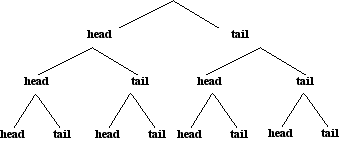1. Complete the following frequency table for the sales of types of cars and use the table to answer the questions:
a. Which type of car was the most popular?
b. Which type of car was the least popular?
c. Fill in the three missing totals on the bottom row of the table.
|
2. A die is thrown. What is the probability of throwing:
|
3. A bag contains 6 white balls and 4 red balls. A student takes a ball from the bag.
What is the probability that the ball is:
a. White?
b. Red?
c. Green?
d. Red or white?
4. A blindfolded person throws a dart at a dart board split into 8 equal parts and marked with numbers from 1 to 6 as in the diagram. All darts hit the board.
The circle shown has angles of 90° and 45o
a. What is the probability of scoring a 4?b. What is the probability of scoring a 6?
c.What is the probability of scoring an odd number?
d.If the person throws 100 darts, how many times would you expect a 1 to be scored?
5. a. From the tree diagram below how many different combinations are possible when tossing a coin three times?

b. If the coin is fair and the probability of getting a head or a tail is one half, what is the probability of getting a head followed by a head followed by a head?
6, If a driver does not have a warrant of fitness or a current licence on his or her car, he or she can either get a ticket or a warning. Draw a tree diagram to show all of the possible combinations when a driver is stopped. (There are 4 in total.)
7. There are 3 red marbles and 7 blue marbles in a bag. A person picks out a marble and notes the colour and then puts the marble back in the bag. He repeats this action.
a. Complete the tree diagram below to show the possibilities.
b. How many possible combinations are there?c. Draw the tree diagram again and mark on the probabilities of each branch.d. What is the probability that a red ball will be chosen followed by a blue ball?e. Redraw the diagram and probabilities if the person does NOT put the first marble back in the bag.f. What is the new probability that a red ball will be chosen followed by a blue ball?

